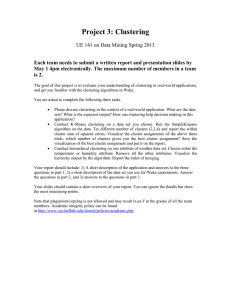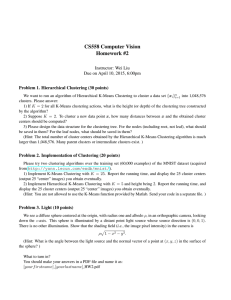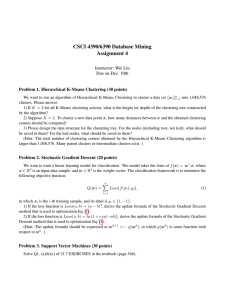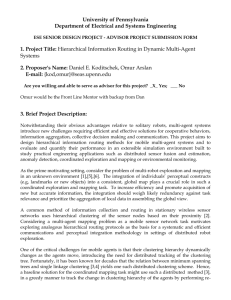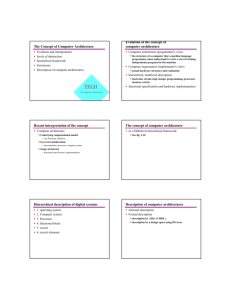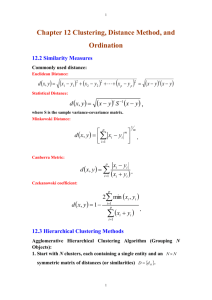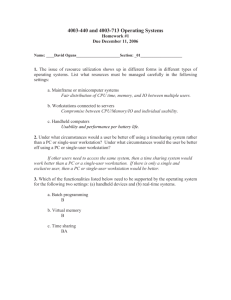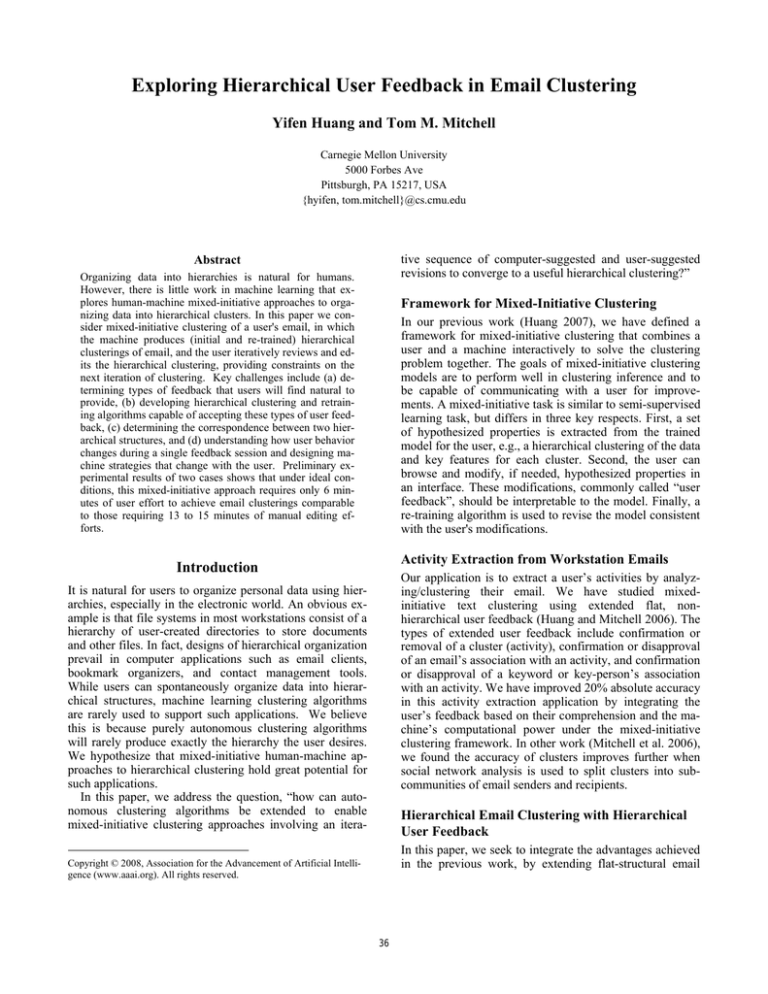
Exploring Hierarchical User Feedback in Email Clustering
Yifen Huang and Tom M. Mitchell
Carnegie Mellon University
5000 Forbes Ave
Pittsburgh, PA 15217, USA
{hyifen, tom.mitchell}@cs.cmu.edu
tive sequence of computer-suggested and user-suggested
revisions to converge to a useful hierarchical clustering?”
Abstract
Organizing data into hierarchies is natural for humans.
However, there is little work in machine learning that explores human-machine mixed-initiative approaches to organizing data into hierarchical clusters. In this paper we consider mixed-initiative clustering of a user's email, in which
the machine produces (initial and re-trained) hierarchical
clusterings of email, and the user iteratively reviews and edits the hierarchical clustering, providing constraints on the
next iteration of clustering. Key challenges include (a) determining types of feedback that users will find natural to
provide, (b) developing hierarchical clustering and retraining algorithms capable of accepting these types of user feedback, (c) determining the correspondence between two hierarchical structures, and (d) understanding how user behavior
changes during a single feedback session and designing machine strategies that change with the user. Preliminary experimental results of two cases shows that under ideal conditions, this mixed-initiative approach requires only 6 minutes of user effort to achieve email clusterings comparable
to those requiring 13 to 15 minutes of manual editing efforts.
Framework for Mixed-Initiative Clustering
In our previous work (Huang 2007), we have defined a
framework for mixed-initiative clustering that combines a
user and a machine interactively to solve the clustering
problem together. The goals of mixed-initiative clustering
models are to perform well in clustering inference and to
be capable of communicating with a user for improvements. A mixed-initiative task is similar to semi-supervised
learning task, but differs in three key respects. First, a set
of hypothesized properties is extracted from the trained
model for the user, e.g., a hierarchical clustering of the data
and key features for each cluster. Second, the user can
browse and modify, if needed, hypothesized properties in
an interface. These modifications, commonly called “user
feedback”, should be interpretable to the model. Finally, a
re-training algorithm is used to revise the model consistent
with the user's modifications.
Activity Extraction from Workstation Emails
Introduction
Our application is to extract a user’s activities by analyzing/clustering their email. We have studied mixedinitiative text clustering using extended flat, nonhierarchical user feedback (Huang and Mitchell 2006). The
types of extended user feedback include confirmation or
removal of a cluster (activity), confirmation or disapproval
of an email’s association with an activity, and confirmation
or disapproval of a keyword or key-person’s association
with an activity. We have improved 20% absolute accuracy
in this activity extraction application by integrating the
user’s feedback based on their comprehension and the machine’s computational power under the mixed-initiative
clustering framework. In other work (Mitchell et al. 2006),
we found the accuracy of clusters improves further when
social network analysis is used to split clusters into subcommunities of email senders and recipients.
It is natural for users to organize personal data using hierarchies, especially in the electronic world. An obvious example is that file systems in most workstations consist of a
hierarchy of user-created directories to store documents
and other files. In fact, designs of hierarchical organization
prevail in computer applications such as email clients,
bookmark organizers, and contact management tools.
While users can spontaneously organize data into hierarchical structures, machine learning clustering algorithms
are rarely used to support such applications. We believe
this is because purely autonomous clustering algorithms
will rarely produce exactly the hierarchy the user desires.
We hypothesize that mixed-initiative human-machine approaches to hierarchical clustering hold great potential for
such applications.
In this paper, we address the question, “how can autonomous clustering algorithms be extended to enable
mixed-initiative clustering approaches involving an itera-
Hierarchical Email Clustering with Hierarchical
User Feedback
In this paper, we seek to integrate the advantages achieved
in the previous work, by extending flat-structural email
Copyright © 2008, Association for the Advancement of Artificial Intelligence (www.aaai.org). All rights reserved.
36
Figure 1: An interface that presents hierarchical results to a user and allows various types of hierarchical and non-hierarchical user feedback. The left panel shows the resulting hierarchy. When a user selects a cluster in the hierarchy, the middle top panel shows a list of emails
in this cluster, and the middle bottom panel would show content of an email chosen by the user. The right panels show key-persons and
keywords associated with this cluster. In this example, the user thinks cluster 4 is related to a specific course (the confirmed key-person is
the TA), which should be under a general course cluster. The user has added a “course” cluster, A.1, and is moving cluster 4 underneath
cluster A.1.
clustering to hierarchical clustering, and to explore the
nature of user feedback for such hierarchical clustering
problems. We build a hierarchical email clustering task
composed of the following steps: (1) generating initial hierarchical clusters of depth two by using a generative clustering model in the first level and social network analysis
for the second, (2) presenting the hierarchical clustering
results in a user interface and recording users’ modifications of the hierarchical clustering with time stamps, and
(3) re-training the hierarchical clustering model according
to this hierarchical user feedback.
Figure 1 shows our design of a user interface that can
accept various types of hierarchical and non-hierarchical
user feedback.
• Cluster-Add: when there is no cluster that represents a
certain idea a user has in mind, the user can create a new
cluster and place it under a reasonable parent cluster.
• Cluster-Split: when a cluster is noisy and a user thinks
that it mixes up different ideas and still wants to keep it,
a user may request that the computer split this cluster into smaller clusters.
• Cluster-Move: a user can drag and drop this cluster under
a more reasonable parent cluster.
• Cluster-Merge: when a user thinks a cluster contains a
repetitive idea that has been represented in another cluster, the user can merge the two clusters.
• Document-Move: a user can drag and drop a document
from its current cluster to another cluster.
Types of Hierarchical User Feedback
Table 1: Feedback types currently in our system: (*) are new
feedback types added to accommodate hierarchical clustering.
Level
Cluster
Document
Feature
Type
Non-hierarchical
Confirm
Confirm
Confirm
feedback
(Remove)
Remove
Remove
Hierarchical
Remove*
feedback
Add*
Move*
Move*
Merge*
We can categorize several types of hierarchical user feedback. Five of them relate to modifying parent-child or sibling relationships in a cluster hierarchy. The sixth type relates to moving a document to another cluster. These feedback types are supported by the user interface shown in
Figure 1.
• Cluster-Remove: when a cluster is too noisy to be understood or a user doesn’t think the idea conveyed by the
cluster is significant, the user may remove this cluster
and its descendants.
37
We have integrated five of these six feedback types
(cluster-splitting feedback is skipped) into our first mixedinitiative hierarchical clustering system. In addition to hierarchical user feedback, we still keep all non-hierarchical
user feedback types we have studied in our previous work.
These previous feedback types consist of positive and negative feedback on clusters, documents, and features within
individual clusters. Table 1 shows a list of feedback types
currently in our system.
We define “complete hierarchical user feedback” as a
modification from an imperfect hierarchy, which contains
undesirable parent-child and sibling relationships (from the
user’s perspective), to a reference (target) hierarchy. Since
it is not practical to expect complete hierarchical feedback
from a user, a user can quit whenever they want, and leave
the machine to retrain the hierarchical model starting from
the user-modified hierarchy and subject to their nonhierarchical feedback.
as the “Cascading SpeClustering model” in the rest of the
paper.
For this email clustering task, we extract both word features and person features from the email corpus. The SpeClustering algorithm has an extension to multiply probabilities of different feature sets, so it can handle word and
person features jointly. In order to simulate the social network analysis that is used to obtain the initial hierarchical
clustering result, we add a “PersonWeight” parameter for
the second and deeper levels in the hierarchy. The value of
PersonWeight multiplies counts in the person corpus. This
produces a double counting effect in the SpeClustering
model so the final classifier will be biased towards the person corpus like what social network analysis does.
The user's hierarchical feedback is embedded in the usermodified hierarchy, used for model retraining. However,
the user modification is most likely not complete. Therefore, we add a “PriorProb” parameter that indicates the
machine's belief that the user left documents at the correct
locations in the hierarchy. When the parameter is 1, the
algorithm preserves these document-to-cluster assignments. When the parameter is lower, the re-trained model
has more freedom to re-assign documents to other clusters
within the hierarchy.
For each intermediate node, the SpeClustering classifier
is trained using the relevant feedback entries. We extract
feedback entries relevant to this node and all its descendant
nodes so descendants’ feedback entries can propagate to
their parent and ancestor nodes. We need to convert hierarchical feedback entries to positive/negative feedback because the SpeClustering model accepts only nonhierarchical feedback. For example, a document-move
feedback entry can be converted to a negative feedback
entry for the original cluster and a positive feedback entry
for the target cluster.
Alternative hierarchical models like the shrinkage model
(McCallum et al. 1998) or Hierarchical Latent Dirichlet
Allocation (Blei et al. 2003) are both possible. For the
shrinkage model, we need to design model adaptation heuristics for feature feedback types. Hierarchical Latent Dirichlet Allocation was our first choice but the Markov
chain processes’ slow convergence contradicts our goal of
efficient interaction between machine and user.
Retraining the Hierarchical Model
As mentioned above, we generate initial hierarchical
clusters of depth two by using a generative clustering model in the first level and applying social network analysis for
the second level to produce purer sub-clusters. The results
from this approach often contain many errors in parentchild relationships and almost no correct sibling relationships. The benefit of using social network analysis is not to
generate good siblings in the hierarchy, but to create separate social cliques (purer sub-clusters) so a user can understand and manipulate them more easily. After a user feedback session on this initial hierarchical result, we retrain
the hierarchical model based on the user modified hierarchy and feedback.
The re-training algorithm re-uses the user-modified hierarchy but adjusts the document-to-cluster assignments. It
adopts the “Pachinko-machine” concept described in (Koller and Sahami 1997) and trains a SpeClustering model as
the classifier for the root node and intermediate nodes.
Each document is distributed to one sub-cluster for further
training. The distribution is based on the document’s posterior probabilities given the model of the parent node. The
SpeClustering model is a probabilistic clustering model we
developed in (Huang and Mitchell 2006). It stands for
“Specific Clustering”, and refers to the fact that the probabilistic model estimates a latent variable for each feature
(word or person) to determine whether it is relevant to or
independent of a specific cluster. Put another way, the
SpeClustering algorithm assumes that each document is a
mixture of two distributions of features – one distribution
that is specific to the cluster, and one distribution that is
independent of the cluster. Since we train separate SpeClustering classifiers for root and intermediate nodes, this
is similar to performing different soft feature selections at
each node. The SpeClustering algorithm supports feedback
adaptation for all non-hierarchical user feedback types
shown in Table 1. We will refer to this hierarchical model
Distance Measurement between Hierarchies
Another important problem in mixed-initiative hierarchical
clustering is evaluating the performances of hierarchical
results (including initial hierarchical results, hierarchies
modified after user feedback, and re-trained hierarchical
clustering results.) The solution of this problem requires a
distance measurement between the resulting hierarchy and
the reference hierarchy while these two hierarchies don’t
share a common skeleton.
At first, this seems to be a very difficult problem. As
(Sun and Lim 2001) pointed out in hierarchical classification, flat precision/recall measurements do not consider the
38
1
hierarchical structure. They proposed heuristic measurements that consider degree of misclassification.
Instead of calculating hierarchical similarities, differences between two hierarchies can be measured by the
number of editing operations needed to change one hierarchy into the other. This measurement is more suitable for
our mixed-initiative scenario which allows hierarchical
user feedback. The set of editing operations are defined by
the set of hierarchical feedback types. We will explain this
idea in further detail using the following example.
In our previous flat clustering task, we found a one-toone accuracy-maximizing cluster alignment between a
clustering result and its reference. The left-hand side subtree in Figure 2(a) is such an example where cluster (circle
node) 2, 3, 6, and 7 are aligned between two hierarchies
and results in clustering errors of document (triangle node)
13, 19, and 22. However, the one-to-one correspondence
may achieve a sub-optimal result if we take hierarchical
constraints imposed by the clustering result into account.
Figure 2(b) Alignment 1 shows a possible mapping if we
stick with the hierarchical constraints. On the other hand,
Alignment 2 in Figure 2(b) shows a mapping that has higher precision and recall at the document level but violates
the hierarchical constraints. Considering which alignment
is more likely to be identified by a human user when the
whole hierarchy is shown, we suspect that Alignment 2 is
more likely than Alignment 1 because recognizing similar
small clusters is easier for users than generalizing heterogeneous clusters.
Furthermore, considering the optimal feedback steps a
user may give to correct the resulting hierarchy to the reference hierarchy, each new feedback type can be interpreted as a set of edge modifications. “Cluster-move”
feedback is equivalent to modifying the parent orientation
in the moved cluster’s parent-child edge. Similarly, “document-move” feedback is changing the parent end of parent-child edge for the moved document. “Cluster-add”
feedback is equivalent to creating a new node and a new
edge pointing to its specified parent. “Cluster-remove”
feedback is equivalent to removing a node and every edge
linked to it. “Cluster-merge” is slightly different; it can be
treated as performing “document-move” for every document associated with this cluster to the target cluster and
removing the merged cluster.
We define “edge modification ratio” as the minimum
number of feedback steps required for complete hierarchical user feedback, divided by the total number of edges in
the reference hierarchy. The tree labeled "clustering results" in Figure 2 needs five feedback steps that modify
edge e3, e8, e12, e18, and e21 accordingly in order to
match the reference hierarchy. There are 28 edges in the
reference hierarchy, so the edge modification ratio is 0.18
(5/28) for this clustering result.
The concept of “edge modification ratio” is very similar
to “tree edit distance” (Bille 2003) where different feedback types are mapped into different operations and the
cost function is uniform.
Reference
5
18
19
20
9
e2 e2
7 8
e1
15
22
23
24
6
e2
e25
e2
4
e5
14
8
21
e23
e22
e2
1
13
e8
e7
4
e1
e13
e12
e11
e10
e9
17
e3
e2
12
16
4
e20
e19
5
e1
11
7
e18
e17
e1
6
10
3
e6
6
2
e4
25
26
27
28
29
Clustering results
e2
6
e2
e25
e2
4
e7
4
e1
e13
e11
e10
e9
e6
e1
2
e23
e22
e20
e19
e17
e1
6
(a) Left-hand side sub-tree (node 2, 3, 6, and 7) can be aligned between two hierarchies and results in 3 document clustering errors.
Reference
e3
e2
e7
4
e1
e13
e12
1
e1
e10
e9
e6
6
e2
e25
e2
4
e23
e22
e2
1
e20
e19
e18
e17
e1
6
Alignment 1
e2
e2
7
6
e2
e25
e2
4
e7
e23
e22
4
e1
e13
e4
e20
e19
e5
8
e1
e17
e1
6
2
e2
e11
e10
e9
e6
e1
Alignment 2
e2 e2
7 8
6
e2
e25
e2
4
e7
4
e1
e13
e1
e11
e10
e9
e6
e1
2
e23
e22
e20
e19
e5
e1
8
e17
e1
6
5
e1
(b) Two different alignments from a clustering result to a
reference.
Figure 2: Hierarchical structure comparison
39
sults comparable to applying 15 minutes of manual user
efforts. The manual effort savings are 7 minutes and 9 minutes correspondingly. However, when the user moves
into the completion phase, the Cascading SpeClustering
model seems not sophisticated enough to adapt towards
complicated and subtle user feedback.
The PriorProb parameter can be interpreted as the level
of trust placed upon the user modified hierarchy where a
higher value means more trust. Experimental results using
different trust values are shown in Figures 3(b) and 3(d).
Results are heterogeneous for different settings where
sometimes high trust yields better performance but sometimes the opposite. It is unlikely that a fixed optimal strategy exists for this parameter.
To counter this issue, we developed a dynamic strategy
that utilizes the existence of confirmation feedback for
each cluster. If the cluster is confirmed by the user, the
trust level is set high and vice versa. Figure 3(c) and 3(e)
show the results of applying the dynamic strategy, and
duplicate the fixed trust level results with the heavy person
weighting from 3(b) and 3(d) as reference. For example,
Figure 3(e) shows that different trust levels are better in
different phases: fixed low trust in the comprehension
phase outperforms high trust and fixed high trust in the
completion phase out-performs low trust. In contrast to
fixed strategies, the dynamic strategy is able to not only set
trust levels automatically but also achieve good performances in both phases.
Experimental Results
We use an email dataset (EmailYH) that consists of emails
from one author for the hierarchical mixed-initiative email
clustering task. There are 623 emails in this dataset that
have been manually organized as a hierarchy that consists
of 15 cluster nodes including a root and 11 leaf folders. It
contains 6684 unique words and 135 individual people.
In our experiments, a mixed-initiative process consists of
the generation of an initial hierarchical clustering with
depth two, a user feedback session, and model retraining.
In the feedback session, the initial clustering is presented to
the email owner in the user interface we introduced in Section 2 to browse and give feedback. The feedback session
lasts about 20 minutes and each feedback entry is recorded
with its timestamp. Then, the feedback record is used in
model retraining and feedback adaptation. Figure 3 shows
results of two mixed-initiative processes: (a)-(c) are based
on the same initial hierarchical result and (d) (e) are based
on the other initial hierarchical result.
We can observe the user behavior in the feedback session by calculating the edge modification ratio of the usermodified hierarchy over time. The dot-marked (black) lines
in Figure 3 show the user behavior from two feedback sessions which have different initial hierarchical results. We
interpret the user’s manual adjustment as having two phases: a comprehension phase to understand the structure and
a completion phase where error correction is accelerated
and more complicated feedback is given. The vertical
dashed line in 3(a) indicates the hypothesized boundary
between these two phases.
The other lines in Figure 3 show edge modification ratios for retraining hierarchical results. Each marked point
represents a result inferred by a retrained model that uses
the user-modified hierarchy up to that time. The crossmarked (green) lines show the edge modification ratio of
results with no special weighting on the person corpus,
whereas the circle-marked (red) lines show results that give
the person corpus a high weight. Weighting the person
corpus heavily results in a lower edge modification ratio
than when using no special weighting in Figure 3(a) and in
the early stage of 3(d). Lower edge modification means a
user can achieve the reference hierarchy using fewer feedback steps. The result confirms our previous study that
social network analysis helps generate more usercomprehensible clusters (activities), and indicates that the
Cascading SpeClustering model is capable of achieving
results similar to social network analysis. At the late stage
in 3(d), where the edge modification ratio is lower than
most results in 3(a), heavily weighting the person corpus
does not work as well as focusing on the word corpus. This
indicates that our strategy of producing purer sub-clusters
and exploiting user’s comprehension has certain limits.
The dashed horizontal line in 3(a) shows that with 6minute user feedback, the re-trained hierarchical clustering
can achieve the same performance as 13 minutes of user
effort when using completely manual adjustment. The
same situation happens in 3(d) where the hierarchical model adaptation with 6 minutes’ user feedback achieves re-
Conclusions
In this paper, we propose an approach to mixed-initiative
hierarchical clustering, and apply it to hierarchical clustering of email. We notice that hierarchical clustering helps a
user understand the results better than flat clustering. Also,
hierarchical feedback lets a user modify results more efficiently.
In order to evaluate hierarchical clustering quality, we
define “edge modification ratio” to compare resulting hierarchies against a reference hierarchy. This measurement
computes the ratio of edited edges in optimal complete
user feedback sequences over the edge numbers in the reference.
We have applied a simple hierarchical clustering model,
Cascading SpeClustering, to the mixed-initiative email
clustering task and achieved improved performances from
the joint efforts of a machine and a user. We also learned
that a good mixed-initiative system should consider the
sequential differences in a feedback session to develop
timely or dynamic strategies for retraining models based on
multiple types of user feedback.
Acknowledgements
This research was supported by Darpa contract
NBCD030010, as part of the Personal Assistants that Learn
project.
40
References
Huang, Y. 2007. Mixed-Initiative Clustering and Its Application
to Workstation Activity Extraction. Thesis proposal.
Huang, Y. and Mitchell, T. 2006. Text Clustering with Extended
User Feedback, SIGIR.
Mitchell, T., Wang, S., and Huang, Y. 2006. Extracting Knowledge about Users’ Activities from Raw Workstation Contents,
AAAI.
Sun, A. and Lim E. 2001. Hierarchical Text Classification and
Evaluation, ICDM.
Bille, P. 2003. Tree Edit Distance, Alignment Distance and Inclusion, IT University Technical Report.
Koller, D. and Sahami, M. 1997. Hierarchically classifying
documents using very few words. ICML.
McCallum, A., Rosenfeld, R., Mitchell, T., and Ng, A.Y. 1998.
Improving Text Classification by Shrinkage in a Hierarchy of
Classes. ICML.
D. Blei, T. Griffiths, M. Jordan, and J. Tenenbaum. 2003. Hierarchical topic models and the nested Chinese restaurant process.
NIPS.
(a)
(b)
(c)
(d)
(e)
Figure 3: Experimental results of two mixed-initiative processes where (a)-(c) belongs to the same process
and (d) (e) belongs to the other process.
41

